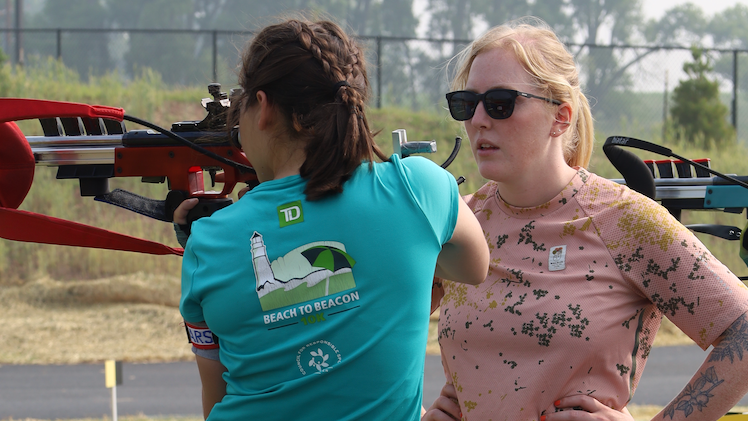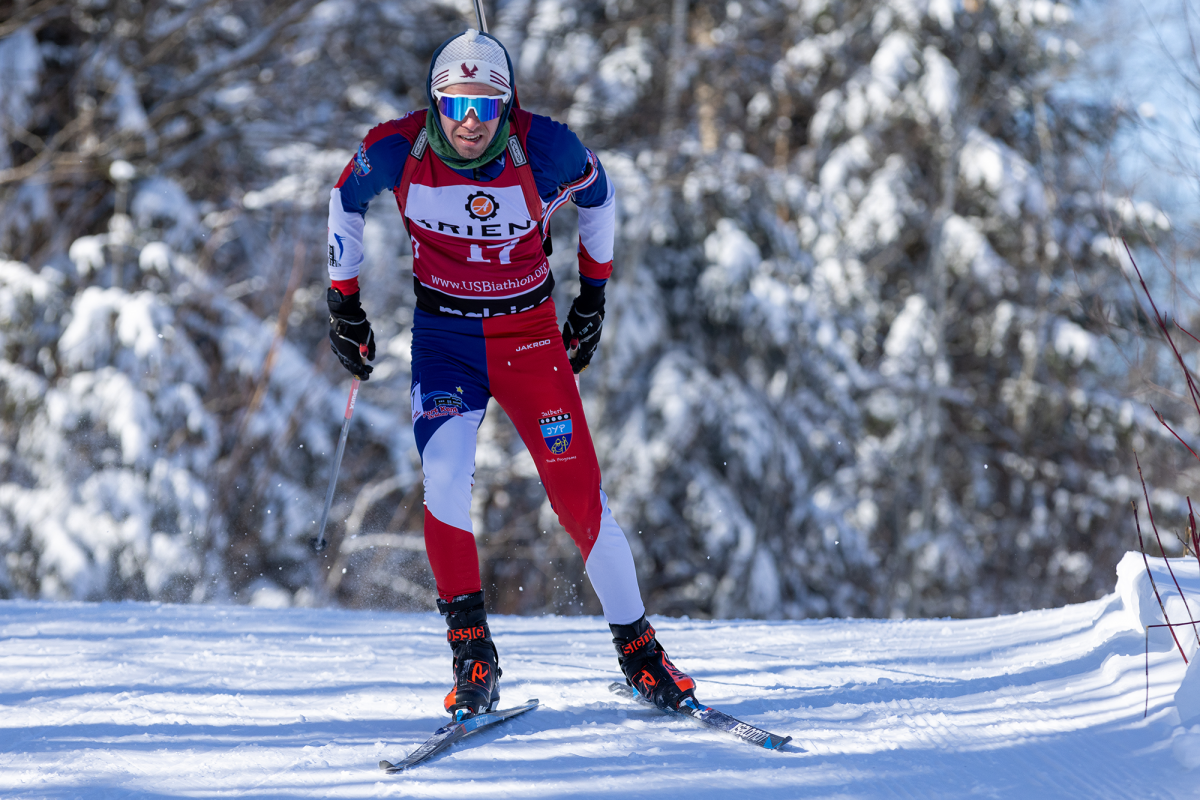
At the start of Sunday’s World Cup men’s pursuit, there was one man out in front: Carl Johan Bergman of Sweden.
After picking up the win in Friday’s sprint in Ostersund, Swedene, Bergman had a seven-second advantage over the rest of the field. But as Friday’s victory was just the second of his career, the big question was how long the 33-year-old would be able to hang onto the lead.
The answer, it turned out, was quite a while. After missing a single shot in the first prone stage, the wiley veteran – who has been a successful anchor on Sweden’s world champion mixed relay team, even if he hasn’t been as successful on his own – used smart strategy to stay in touch with the leaders, Martin Fourcade of France and Tarjei Bø and Emil Hegle Svendsen of Norway. It helped that the Swede had blazing fast skis.
He also might have helped that he had a little added motivation. Bergman lives and trains in Lillehammer, Norway, and frequently sees Bø and Svendsen – who were the top two men in the World Cup rankings last year – on the trails. In Friday’s press conference he talked about how he often thinks of how he can beat them.
For the Americans, there was one man out front, too. After placing fifth in the sprint, Lowell Bailey started the pursuit in no-mans-land, with a gap up to third and fourth and another one behind him. He spent much of the race skiing alone, but thanks to a single penalty over the course of the first three stages he maintained his position.
Behind him Tim Burke, who had started in 12th position, was able to move up quickly. After two clean prone stages, Bailey was in fourth and Burke in sixth. Then Burke missed two shots in his first standing stage, dropping to ninth, but appeared to be skiing easily to maintain a top-ten position.
And so, for both Bergman and the Americans, it came down to the last shooting stage – just as it does in almost any biathlon race.
At the front of the pack, the Swede crumbled, much to the dismay of the home crowd, and missed three shots. While it might have been fatigue from skiing with the world’s best for ten kilometers, it also appeared that the wind picked up just as the front pack was entering the range. For the first time all day, the men started to miss.

All, that is, except for one: Fourcade. Somehow the Frenchman managed to hit all his targets despite the wind, and became the only skier in the field to shoot a perfect twenty for twenty. As soon as he hit the final shot, Fourcade knew he had it in the bag; he turned to the crowd and waved before putting his gun on his back and hitting onto the trail with a guaranteed victory.
As the other racers skied the penalty loop, it seemed that Bailey had an opportunity. But he couldn’t capitalize – whether it was due to wind or fatigue, Bailey missed a crushing three shots.
“Yeah, that was a really tough end to the race,” Bailey wrote in an e-mail.
“Up to that point I had stuck to my game plan and the race was going the way I wanted it to go. But sometimes biathlon is like that. You saw a lot of guys in the top ten struggle during the last stage today. It was a little windy and I felt a little shaky and I just didn’t have a whole lot of luck for the last three shots!”
So while Fourcade sauntered towards the finish, losing a pole along the way, picking up a flag, and taking a bow as he crossed the line, a fight was shaping up for second – without Bailey.
Instead, it was Norwegian veteran Emil Hegle Svendsen and Czech racer Jaroslav Soukup who were battling it out. While Svendsen is no Northug, he does have an impressive sprint, so Soukup – who like his countryman Lukas Bauer is a skinny mountain biker – knew he would have to try to break the champion early if he wanted to beat him.
But breaking Svendsen is something that is easier said than done. It’s practically impossible. Soukup put in a surge on the course’s biggest hills, and seemed to gain a small lead. But it wasn’t large enough to create separation between the two and Svendsen caught up on the downhills. Soukup again tried to pull away coming towards the stadium, but he couldn’t drop the Norwegian.
In the end, the pair started a sprint finish, but Soukup gave up, knowing that he would not beat Svendsen to the line. Instead, he eased up and raised his hands in celebration – while he would have preferred a second-place finish, it was still his first World Cup podium.
“It is beautiful to be up here on the podium,” Soukup told IBU News after the race.

Burke, meanwhile, had only missed one shot, bringing his total to three penalties. He was able to maintain his ninth-place position all the way to the finish for his best result of the season so far. It’s also better than he managed last season, when he was suffering from compartment syndrome.
A surgery during the off-season made all of the difference to his skiing, Burke said.
“My legs are feeling great and I have had no problems with my shins during the races,” he wrote in an e-mail. “The sprint race here was incredibly icy, which would have given me huge problems last year. This was a great test and now I am really looking forward to what I can do when I am in my best form. Today I had the fourth fastest course time and this is something that would not have been possible last year.
“It feels great to be back on track.”
The third U.S. athlete in the pursuit, Jay Hakkinen, skied up from 39th to 24th after collecting only two penalties.
“I stuck to a basic race plan of skiing with those around me and then shoot my way forward, and that was effective,” he wrote in an e-mail.
With Hakkinen showing that he can consistently turn in results like his 18th-place finish from Thursday’s individual race, it was one of the best days for the U.S. men in recent history.
“I don’t remember ever having three Americans in the top 30, but I also am not surprised,” Bailey told FasterSkier. “We have all trained hard this season and I have 100 % trust in our coaches and the training plan they outlined starting in April. Overall it is a great start to the season.”
Burke echoed that sentiment.
“This was definitely the best team results we have ever had since I have been on the team,” he wrote.
While the men have each individually had standout performances, they have struggled to stay consistent from season to season and from race to race. In the past decade, it has seemed that no more than one U.S. man can excel at a time.
But that’s changing.
“I think the biggest difference is that we now have a team with a lot of racing experience,” Burke said. “It can take a long time in biathlon to become comfortable with shooting when the race is on the line. We now have a team where every member has solid World Cup experience.”
While Bailey was frustrated with the end of his race today, he knew that his effort meant good things for the future – and that he had gained some of that valuable experience near the front of the race.
“I’m still happy with a 13th place,” he said. “I was able to ski with the top guys in the world all week, and I am really encouraged by this and looking forward to next week’s competitions in Austria.”
Hakkinen felt similarly.
“[The result] shows that I have a good level… I am pleased I put in some strong performances,” he wrote.
Next week’s races in Hochfilzen, Austria will include a relay, something the Americans are looking forward to given their recent results. But Hakkinen warned against getting overconfident.
“We are simply doing the work we trained to do,” he said. “For example, that all three of us cleaned prone today is a ‘work in progress’ towards improving our overall shooting percentage. I do not think any of us are thinking about what the relay result we will be, we just want to keep skiing well and hit each individual target.
“We still have work to do before we can call it confidence.”
* * *
Canadian Brendan Green started just behind Burke, in 14th position, but his race quickly went in a different direction. While he was able to ski well in the first lap, he missed a shot in his initial prone stage and then two more in the next stage, sealing his fate of dropping out of the top twenty.
“For sure I was a little disappointed with the race, as I had a the perfect opportunity to build off my sprint result,” Green wrote in an e-mail. “I definitely had a tougher time on the range today. I used a more cautious approach in prone with the hope of maintaining my position early on so I could be more aggressive in standing, but that didn’t play out so well. I picked up too many misses early on – apparently the missed shots were just on the edge.”
After missing two more shots in his final standing stage, Green wound up 32nd, a performance he called “mediocre.”
But with the 18th-fastest ski time of the day, there were definite bright spots for the Canadian.
“Overall I’m definitely pleased with the weekend,” he said. “In past years I’ve struggled with the season opener, so to match my best performance in the sprint and score points today is definitely a confidence booster.
“I’m hoping my best shape is still to come and I’m looking forward to the rest of the season.”





One comment
nyctvt
December 4, 2011 at 9:17 pm
Congratulations to Lowell, Tim and Jay. Great way to start off the season!